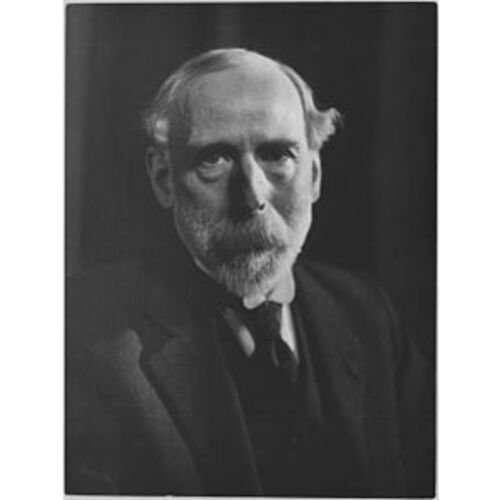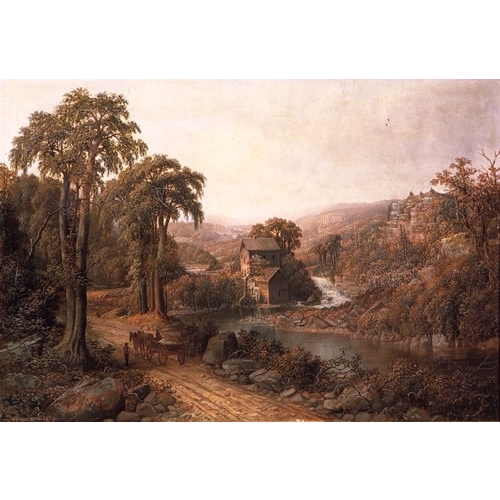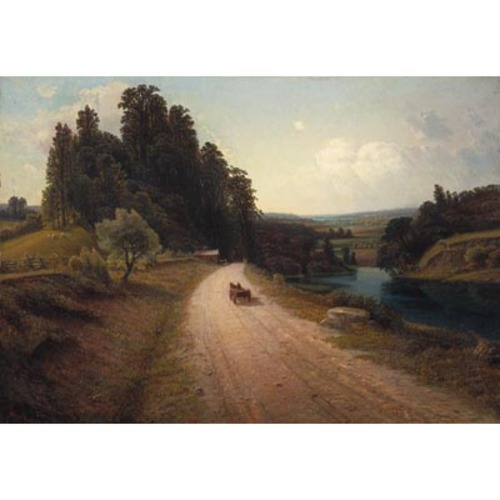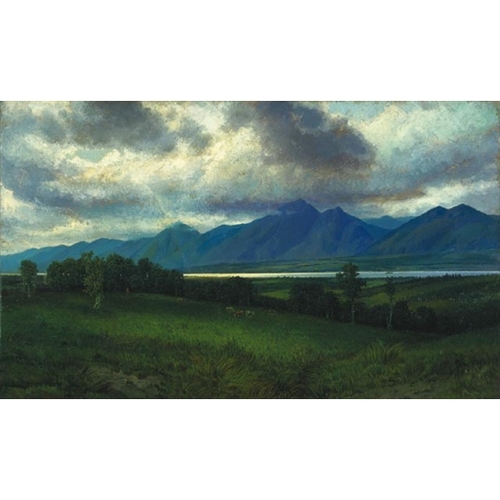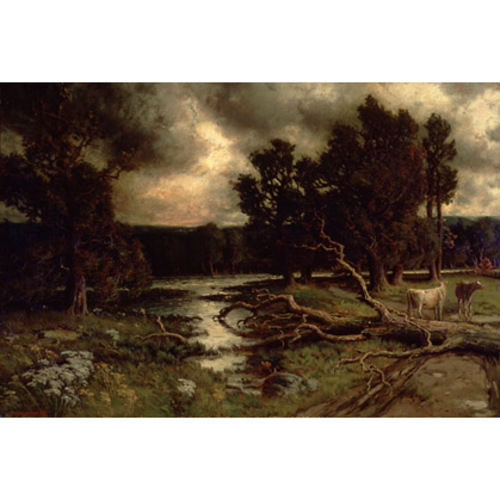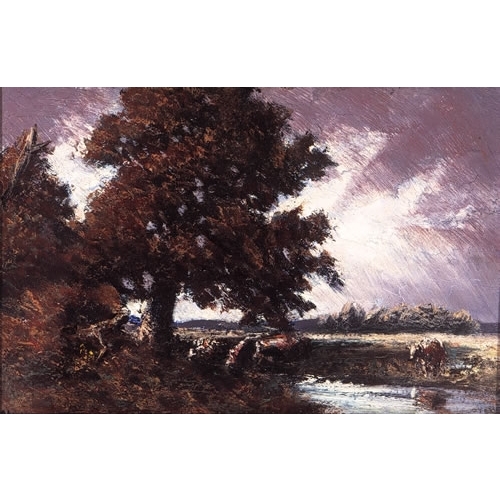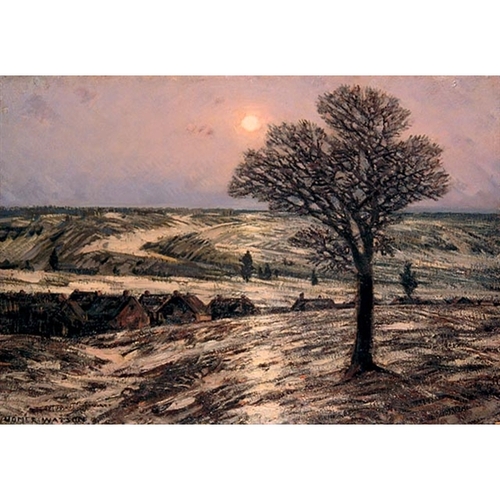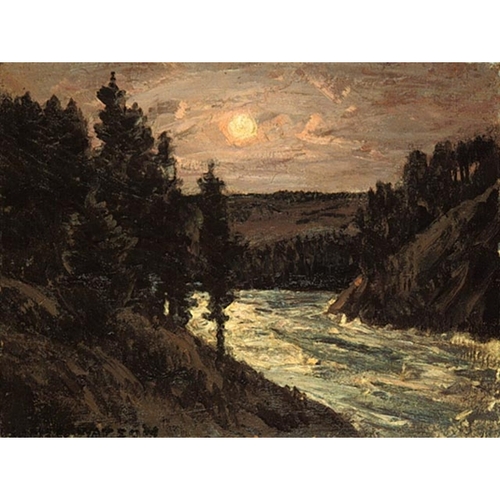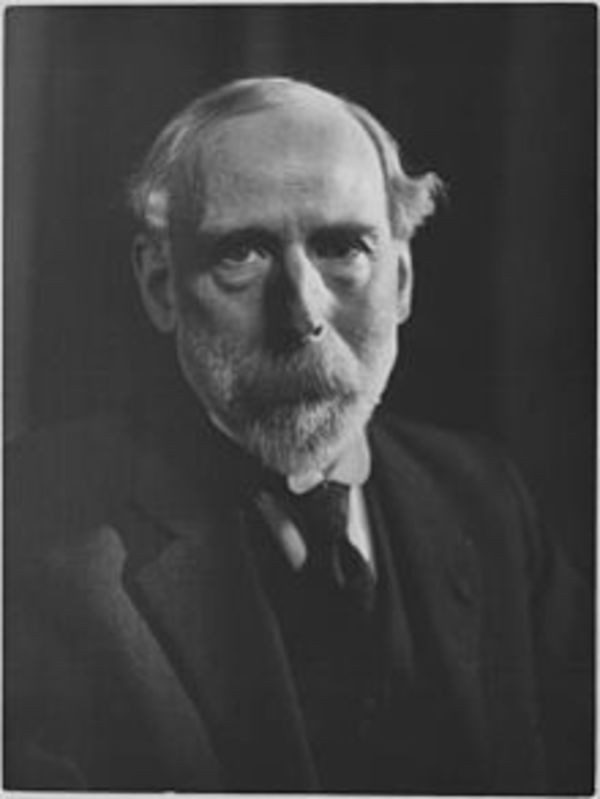
Source: Courtesy of Wikimedia Commons
WATSON, HOMER RANSFORD, artist; b. 14 Jan. 1855 in Doon (Kitchener), Upper Canada, second of the five children of Ransford Watson and Susan (Susannah) Moore (Mohr); m. 1 Jan. 1881 Roxanna (Roxa, Roxie) Bechtel (1855–1918) in Berlin (Kitchener), Ont., and they had a son, who was stillborn, and adopted a daughter; d. 30 May 1936 in Doon, Ont.
Homer Watson was born into a family of modest means. His father, Ransford, operated a woollen mill. By his own admission, Homer was a poor student who preferred sketching to school lessons. A dreamer too, he was reported to have arranged his food on his dinner plate in such a way as to create images. The Watsons fell on hard times when Ransford died in 1861. Some years later, when he was only in grade 6, Homer was forced to leave school to help support the family. Along with his elder brother, Jude Nathan, he found a job in a brickyard. Tragedy struck again when Jude was killed in an accident there in 1867. The deaths affected Homer profoundly and he sought comfort in nature. He could often be found walking in the Grand River valley near his home, lost in reverie. He would subsequently say that these wanderings had had “a dream-like effect” on him and produced romantic notions of his environs. His mystical view of nature and his interest in the spirit world likely took root at this time. In later life he would host regular seances in his home for guests, who included fellow artist Carl Henry Ahrens and Liberal politician William Lyon Mackenzie King*.
At age 15 Homer was given some oil paints by an aunt and set about using them. With no money for formal instruction, he learned by copying pictures in books. A small inheritance from his paternal grandfather gave him the means to move to Toronto in 1874 for a year of study. “I did not know enough to have Paris or Rome in mind,” he would write to a friend. “I felt Toronto had all I needed.” Unable to afford classes, he put up his easel in the foyer of the Normal School. There he copied the reproductions of old-master paintings on display. He also came to know landscapists Henri Perré*, Lucius Richard O’Brien*, and John Arthur Fraser*. In 1876 he was able to spend some months in New York State, where he discovered the Hudson River School of painters. When his funds were exhausted, Watson returned to Doon in 1877 and committed himself to art. As he later wrote, “I obeyed then certain desires which altogether possessed me into fixing in some palpable degree the infinite beauties that emanate from the great mystery of the sky and land.… I became a painter.”
His first major work, The death of Elaine (1877), was inspired by Tennyson’s poem “Lancelot and Elaine.” The work shows the strong influence of the British Romantic School. Elaine would remain one of his few figure studies. The pastoral landscapes in and around Doon – the woodlands, rushing streams, watermills, and grazing cattle – became his predominant subject matter. In the words of curator Darlene Kerr, “Homer Ransford Watson … quite simply loved the woods. It was his sanctum sanctorum, or sacred place.” Watson would later be active in a campaign to conserve an expanse of woodland near his home, known since 1943 as Homer Watson Memorial Park.
In 1878 Watson joined the Ontario Society of Artists (OSA) as a draftsman and designer, and he first exhibited professionally at its annual show that year. The reception from critics was favourable, and shortly afterwards he was elected to the OSA as a painter. More recognition was to follow. In 1880 Governor General Lord Lorne [Campbell*] and his wife, Princess Louise, daughter of Queen Victoria, attended the first exhibition of the Canadian (soon to become Royal Canadian) Academy of Arts (RCA) in Ottawa. So taken was Lorne by Watson’s Pioneer mill that he purchased it for the queen’s collection. The sale, for $300, was the turning point in Watson’s life. The money allowed him to marry his sweetheart, Roxa Bechtel, in 1881. That year Lorne bought a second Watson painting for the queen, The last day of the drought, and the Doon artist’s fame soared. An associate member of the RCA from 1880, he was made a full member in 1882. In 1882, during a visit to Canada, the Irish poet and critic Oscar Wilde viewed an exhibition that included Watson’s work. He was entranced. Pronouncing Watson to be “the Canadian Constable,” a reference to the British landscape painter John Constable, Wilde commissioned a painting for his own collection. The Watsons celebrated these achievements by purchasing the house in Doon (built for Adam Ferrie*, one of the founders of the village) that would become the painter’s permanent gallery.
His success prompted an extended trip with Roxa to the British Isles in 1887–90, the first of a number of visits. There he sketched and also learned to etch. A journey to France opened his eyes to the Barbizon School of landscape painters, especially the work of Jean-François Millet and Camille Corot. But he was soon anxious to return to Doon, convinced, as he later recalled, that he would find “ample material” for artistic expression “among old associations, among the nooks that wove themselves into my early days, and in a certain village nestling among the hills.”
Watson was prolific after his return to Canada: he exhibited an estimated 174 paintings between 1890 and 1899, with major shows being held in London and New York. Sales were brisk; among the Canadian collectors who patronized him were prominent businessmen such as James Ross*. Generally, his art from this period displays the influence of his years abroad. Some, such as Summer storm (c. 1890) and Evening scene (c. 1894), are darker and moodier than his previous works. Commentators have also pointed to his use of broader brushstrokes and thicker paint, a greater concern with colour and light, and more freedom of expression. The flood gate (c. 1900–1) was the painting that contemporaries, and Watson himself, called his masterpiece. It was exhibited to great acclaim at a show in Glasgow. The painting would be acquired for the National Gallery of Canada in 1925 by director Eric Brown.
The 20th century began auspiciously for him when he won a gold medal at the Pan American Exposition in Buffalo, N.Y., in 1901 (one of several international awards he received over the years). In 1907, along with Edmund Montague Morris*, Albert Curtis Williamson*, and others, he was a founding member of the Canadian Art Club. He served as its first president until 1913, when he was succeeded by his friend Horatio Walker. In 1914 he became vice-president of the RCA, under William Brymner*. After war was declared that August, he was commissioned by the minister of militia and defence, Samuel Hughes*, to paint the camp of the Canadian Expeditionary Force in Valcartier, Que. Watson was elected president of the RCA in 1918, but he withdrew from public life four years later, in part because of increasing deafness.
By 1910 Watson’s work had begun to receive more intense scrutiny as newer talents sought to define the Canadian landscape. Sales of his paintings started to decline. With the formation in 1920 of the Group of Seven, “the Canadian Constable” became an anachronism. The so-called real and raw Canada, as portrayed in the radical canvases of Arthur Lismer*, Alexander Young Jackson*, Lawren Stewart Harris*, and their associates, increasingly dominated the country’s art world. Sensing the shift in the wind, Watson struggled to adapt. His style became more Impressionistic as he sought to work out his own modernism, which did not, he said, “lend itself to the elimination of the pictorial.” Yet most art historians view his paintings from 1920 on as weaker efforts. The stock-market crash of 1929 left Watson virtually penniless. Two years later he transferred ownership of his unsold works to the Waterloo Trust and Savings Company in exchange for monthly living expenses. He continued to paint, but his financial situation remained difficult. “I am in rather tight straits for want of money,” he wrote to his patron James Livingston* in 1933. “The reason is the winter has been altogether a knock-out for no one could come as expected to buy.”
Homer Watson died in 1936 at the age of 81, just a month before he was awarded an honorary doctorate by the University of Western Ontario in London. His sister Phoebe Amelia, also an artist, who had moved in with him and his daughter after Roxa died, lived in the Watson home until her death in 1947. The following year the Doon School of Fine Arts was established in the house; it ran until 1966, drawing such distinguished teachers as Frederick Horsman Varley* and Carl Fellman Schaefer*. In 1980 the property was designated a national historic site. Purchased by the City of Kitchener, it opened a year later as the Homer Watson House and Gallery.
A portrait of Homer Ransford Watson by A. Curtis Williamson is held by the National Gallery of Can. in Ottawa. In addition to the paintings in the Royal Coll. Trust, Windsor Castle, Eng., Watson’s work is preserved in the U.K. at the Kelvingrove Art Gallery and Museum, Glasgow; in Canada he is represented in the National Gallery of Can., Ottawa, and in many provincial and municipal repositories across the country, particularly the Kitchener-Waterloo Art Gallery and the Homer Watson House & Gallery, both in Kitchener, Ont. A select list of repositories may be found in the “Artists in Canada” database at app.pch.gc.ca/application/aac-aic. In 2005, in commemoration of the 150th anniversary of Watson’s birth, Canada Post issued two stamps bearing his works (Down in the Laurentides and The flood gate).
Castle Kilbride Museum (Wilmot, Ont.), Homer Watson to J. P. Livingston, October 1933. National Gallery of Can., Library & Arch., Homer Watson fonds. QUA, Homer Ransford Watson fonds, box II, no.12. Brian Foss, “Homer Watson and The pioneer mill,” Journal of Canadian Art Hist. (Montreal), 33 (2012), no.1: 47–82. Darlene Kerr, The landscapes of Homer Watson: a particular time and place (exhibition catalogue, Homer Watson House & Gallery, 2000). Muriel Miller, Homer Watson: the man of Doon (Toronto, 1938). G. [A.] Noonan, Refining the real Canada: Homer Watson’s spiritual landscape: a biography, ed. Paul Tiessen (Waterloo, Ont., 1997). F. E. Page, Homer Watson: artist and man (Kitchener, 1939). Jane VanEvery, With faith, ignorance and delight: Homer Watson (Doon [Kitchener], 1967).
Cite This Article
Nancy Silcox, “WATSON, HOMER RANSFORD,” in Dictionary of Canadian Biography, vol. 16, University of Toronto/Université Laval, 2003–, accessed December 28, 2025, https://www.biographi.ca/en/bio/watson_homer_ransford_16E.html.
The citation above shows the format for footnotes and endnotes according to the Chicago manual of style (16th edition). Information to be used in other citation formats:
| Permalink: | https://www.biographi.ca/en/bio/watson_homer_ransford_16E.html |
| Author of Article: | Nancy Silcox |
| Title of Article: | WATSON, HOMER RANSFORD |
| Publication Name: | Dictionary of Canadian Biography, vol. 16 |
| Publisher: | University of Toronto/Université Laval |
| Year of publication: | 2022 |
| Year of revision: | 2022 |
| Access Date: | December 28, 2025 |


